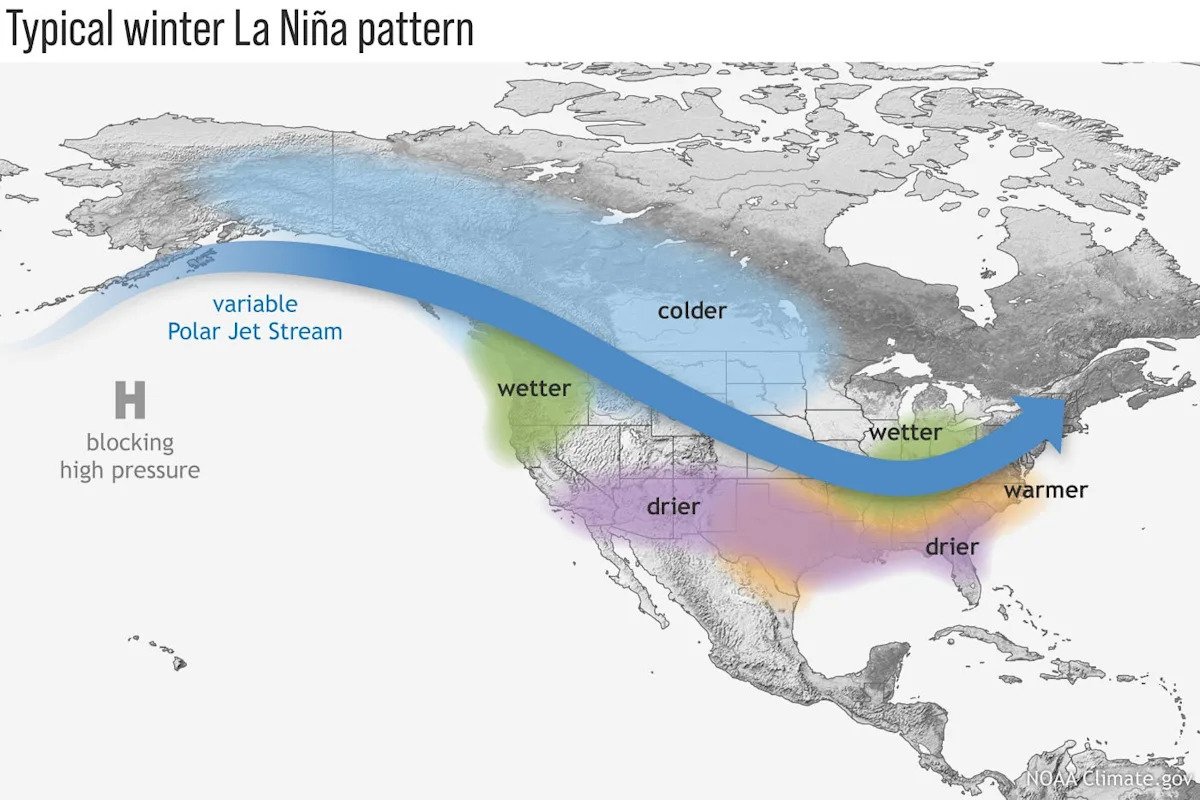Breaking News
La Niña will dominate winter weather, federal forecasters say

Climate troublemaker La Niña will play a starring role in the United States’ winter weather, federal forecasters from the Climate Prediction Center said Thursday, Nov. 13.
“La Niña continued over the past month, as indicated by the strengthening of below-average sea surface temperatures across the central and eastern equatorial Pacific Ocean,” the prediction center said in a statement.
La Niña is a part of a natural climate cycle officially known as El Niño-Southern Oscillation, what scientists call ENSO. The cycle swings between warmer and cooler seawater in a region along the equator in the tropical Pacific Ocean. La Niña is marked by cooler-than-average ocean water in the region.
Those subtle changes can have big ripple effects across the globe’s climate, with the cycle at times increasing the chances for rain, drought, hurricanes and other chaos. The effects vary drastically by region, even within the United States.
Although on the weak side, federal forecasters still say this La Niña will be the primary driver of winter weather in the United States.
Its impact is likely to be strongest during the winter season and so plays a large role in the CPC’s recently released winter outlook, Jon Gottschalck, chief of the operational prediction branch of the Climate Prediction Center, told USA TODAY.
La Niña also acts to boost hurricane activity in the Atlantic Basin. Fortunately, the hurricane season is all but over, so La Niña should have no impact in that respect this year.
What does La Niña mean for winter weather? Map shows typical pattern.

Typical wintertime impacts of La Nina in the United States.
What is La Niña?
La Niña is a part of a natural climate cycle officially known as El Niño-Southern Oscillation, called ENSO by scientists. The cycle swings between warmer and cooler seawater in a region along the equator in the tropical Pacific. La Niña is marked by cooler-than-average ocean water in the region.
It is one of the main drivers of weather in the United States, especially during the late fall, winter and early spring. It’s the opposite of the more well-known El Niño, which occurs when Pacific Ocean water is at least 0.9 degrees warmer than average for three months.
The intermediate stage is known as ENSO-Neutral, when neither La Niña nor El Niño are present.
How cold, snowy will winter be? New NOAA forecast holds clues.
What’s the winter forecast?
According to the CPC’s winter forecast, a warmer-than-average winter is most likely across the southern tier of the nation, as well as in California and along much of the East Coast and Florida. Colder-than-normal conditions are expected in the Pacific Northwest and across the upper Midwest.
As for snow and rain, the northern Rockies and Great Lakes region are most likely to see plenty of precipitation this winter, the Climate Prediction Center said. However, a drier-than-average winter is expected along the nation’s southern tier, especially in the Southeast.
The center’s forecast covers the months of December, January and February, which is known as meteorological winter.
What other factors are at play?
AccuWeather’s recently released U.S. winter forecast also pointed to La Niña as one of the key drivers of the upcoming season, according to AccuWeather senior meteorologist and long-range expert Paul Pastelok. In an online forecast, he said La Niña conditions will likely affect snow, rain and temperature trends nationwide, but he emphasized that this year’s La Niña appears to be weak, which leaves room for other oceanic factors to influence the forecast.
One of those factors is a marine heat wave spanning much of the northern Pacific Ocean, stretching from Japan to the U.S. West Coast.
“These waters off the West Coast and extending farther out are very, very important going into our (winter) forecast this year,” Pastelok explained. He added that there have not been many winter seasons in recent decades that have had a similar setup across such a vast area of the ocean.
Why is the La Niña forecast important?
“Seasonal forecasts for El Niño and La Niña and their associated impacts on our weather are an important climate intelligence tool,” said World Meteorological Organization secretary-general Celeste Saulo, in a recent statement.
“They translate into millions of dollars of economic savings for key sectors like agriculture, energy, health and transport and have saved thousands of lives when used to guide preparedness and response actions,” she added.
This article originally appeared on USA TODAY: La Niña will dominate winter weather in 2025-2026. What to expect.
